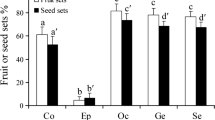Abstract
Although sexuality is considered evolutionarily progressive, clonality is very common in plants and the prevailing means of reproduction in several community types. I discuss what could be the forces that have influenced the selection among sexual versus non-sexual reproduction at community level. I propose that, among others, the probability of self-competition must have been one of the key factors. The probability of meeting one’s own genes for wasteful competition is higher in communities where clonality prevails (and relatively high mean intra-species relatedness is expected), and higher in communities with low species diversity. On the other hand, lower diversity indicates a higher average fitness of species since the (finite) total pool of resources is distributed among fewer population with high density. I show, using four community types with contrasting diversity and clonality that community fitness (average fitness in the assemblage of species) can be expressed as the product of two variables––anti-diversity and degree of sexuality.


Similar content being viewed by others
References
Ayala FJ (1998) Is sex better? Parasites say “no”. Proc Natl Acad Sci USA 95:3346–3348
Callaway RM (1997) Positive interactions and the individualistic-continuum concept. Oecologia 112:143–149
Charlesworth B (1989) The evolution of sex and recombination. TREE/Trends Ecol Evol 4:264–267
Cheplick GP (1992) Sibling competition in plants. J Ecol 80:567–575
Clements FE (1916) Plant succession: analysis of the development of vegetation. Carnegie Inst Wash Pub 242:1–512
Eckert CG (2001) The loss of sex in clonal plants. Evol Ecol 15:501–520
Eriksson O (1997) Clonal life histories and the evolution of seed recruitment. In: de Kroon H (ed) The ecology and evolution of clonal plants. Backhuys Publishers, Leiden, pp 211–226
Falik O, Reides P, Gersani M, Novoplansky A (2003) Self/non-self discrimination in roots. J Ecol 91:525–531
Gersani M, Brown JS, O’Brien EE, Maina GM, Abramsky Z (2001) Tragedy of the commons as a result of root competition. J Ecol 89:660–669
Gruntman M, Novoplansky A (2004) Physiologically mediated self/non-self discrimination in roots. Proc Natl Acad Sci USA 101:3863–3867
Holzapfel C, Alpert P (2003) Root cooperation in a clonal plant: connected strawberries segregate roots. Oecologia 134:72–77
Hutchings MJ, Barkham JP (1976) An investigation of shoot interactions in Mercurialis perennis L., a rhizomatous perennial herb. J Ecol 64:723–743
Kull K, Zobel M (1991) High species richness in an Estonian wooded meadow. J Veg Sci 2:711–714
Lepik M, Liira J, Zobel K (2005) High shoot plasticity favours plant coexistence in herbaceous vegetation. Oecologia 145:465–474
Michod RE (1982) The theory of kin selection. Annu Rev Ecol Syst 13:23–55
Peet RK (1974) The measurement of species diversity. Annu Rev Ecol Syst 5:285–307
Ricklefs RE, Miller GL (1999). Ecology. W. H. Freeman and Company, New York
Routledge RD (1979) Diversity indices; which ones are admissible? J Theor Biol 76:503–515
Stuefer JF, During HJ, de Kroon H (1994) High benefits of clonal integration in two stoloniferous species, in response to heterogeneous light environments. J Ecol 82:511–518
Taylor PD (1979) An analytical model for a short-term advantage of sex. J Theor Biol 81:407–421
Tiffney BH, Niklas CJ (1985) Clonal growth in land plants, a paleobotanical perspective. In: Jackson JB, Buss LW, Cook EE (eds) Population biology and evolution of clonal organisms. Yale University Press, New Haven, pp 35–66
Watt AS (1947) Pattern and process in the plant community. J Ecol 35:1–22
Acknowledgements
I thank Marina Semchenko, John Davison and an anonymous referee for helpful comments and linguistic corrections. Rein Kalamees kindly helped with the figures. This work was supported by Estonian Science Foundation (5535) and University of Tartu (2540).
Author information
Authors and Affiliations
Corresponding author
Rights and permissions
About this article
Cite this article
Zobel, K. On the forces that govern clonality versus sexuality in plant communities. Evol Ecol 22, 487–492 (2008). https://doi.org/10.1007/s10682-007-9236-y
Received:
Accepted:
Published:
Issue Date:
DOI: https://doi.org/10.1007/s10682-007-9236-y




